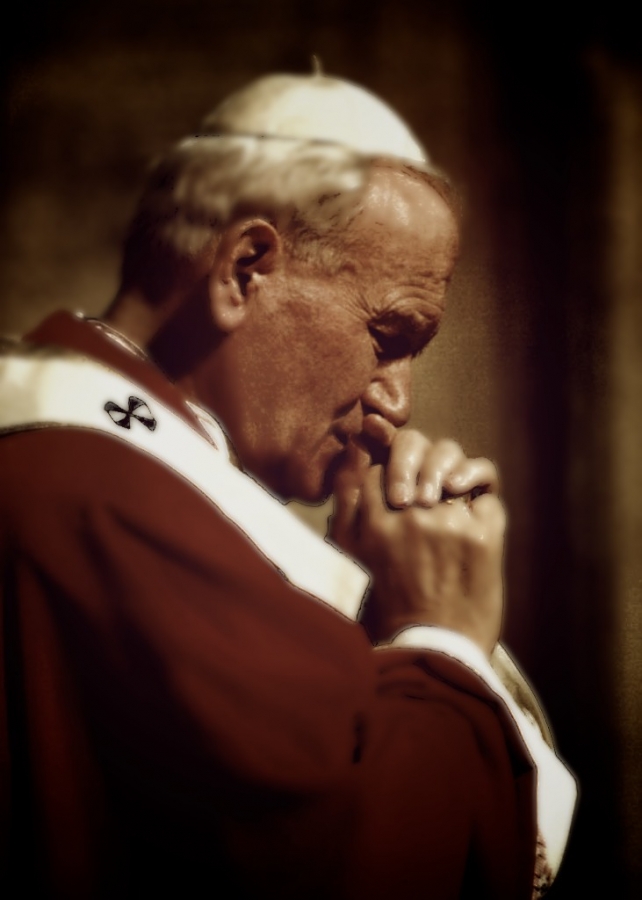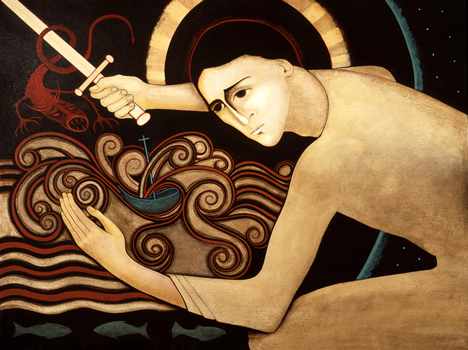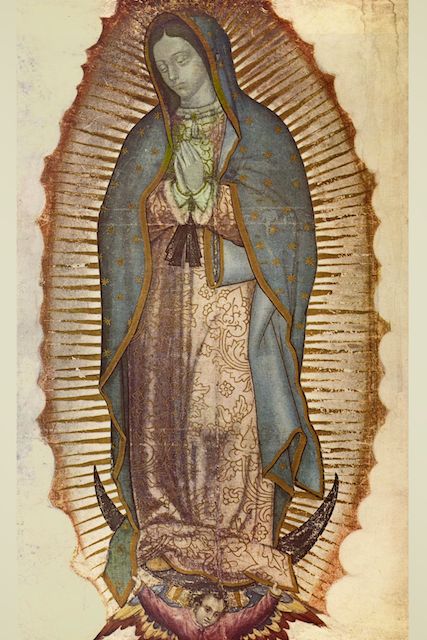
WHAT did John Paul II mean when he said “we are facing the final confrontation”? Did he mean the end of the world? The end of this age? What exactly is “final”? The answer lies in the context of all that he said…
THE GREATEST HISTORICAL CONFRONTATION
We are now standing in the face of the greatest historical confrontation humanity has gone through. I do not think that wide circles of the American society or wide circles of the Christian community realize this fully. We are now facing the final confrontation between the Church and the anti-Church, of the Gospel and the anti-Gospel. This confrontation lies within the plans of divine providence. It is a trial which the whole Church… must take up. —Cardinal Karol Wojtyla (JOHN PAUL II), reprinted November 9, 1978, issue of The Wall Street Journal from a 1976 speech to the American Bishops
We are standing in the face of the greatest historical confrontation humanity has gone through. What is it that we have gone through?
 In my new book, The Final Confrontation, I answer that question by examining in particular how “the dragon”, Satan, “appeared” shortly after Our Lady of Guadalupe’s apparition in the 16th century. It was to signal the beginning of a great confrontation.
In my new book, The Final Confrontation, I answer that question by examining in particular how “the dragon”, Satan, “appeared” shortly after Our Lady of Guadalupe’s apparition in the 16th century. It was to signal the beginning of a great confrontation.
…her clothing was shining like the sun, as if it were sending out waves of light, and the stone, the crag on which she stood, seemed to be giving out rays. —St. Juan Diego, Nican Mopohua, Don Antonio Valeriano (c. 1520-1605 A.D,), n. 17-18
A great sign appeared in the sky, a woman clothed with the sun, with the moon under her feet, and on her head a crown of twelve stars. Then another sign appeared in the sky; it was a huge red dragon, with seven heads and ten horns, and on its heads were seven diadems… (Rev 12:1-4)
Prior to this time, the Church had been weakened by schism, political abuses, and heresy. The Eastern Church had broken away from the Mother Church into the “Orthodox” faith. And in the West, Martin Luther created a storm of dissension as he openly questioned the authority of the Pope and the Catholic Church, arguing instead that the Bible alone was the sole source of divine revelation. It lead in part to the Protestant Reformation and the beginnings of Anglicanism—in the same year Our Lady of Guadalupe appeared.
With the Catholic/Orthodox split, the Body of Christ was now breathing with only one lung; and with Protestantism dislocating the rest of the Body, the Church appeared anemic, corrupt, and incapable of providing a vision for mankind. Now—after 1500 years of cunning preparation—the dragon, Satan, had finally created a lair in which to draw the world to himself and away from the Church. Like the Komodo dragon found in parts of Indonesia, he would first poison his prey, and then wait for it to succumb before he attempted to destroy it. His poison was philosophical deception. His first poisonous strike came toward the end of the 16th century with the philosophy of deism, generally traced to the English thinker, Edward Herbert:
…deism… was a religion without doctrines, without churches, and without public revelation. Deism retained a belief in a Supreme Being, right and wrong, and an afterlife with rewards or punishments… A later view of deism viewed God [as] the Supreme Being who designed the universe and then left it to its own laws. —Fr. Frank Chacon and Jim Burnham, Beginning Apologetics 4, p. 12
It was a philosophy that became the “religion of the Enlightenment” and set the stage for mankind to begin taking a moral and ethical view of himself apart from God. The dragon would wait five centuries for the poison to work its way through the minds and cultures of civilizations until it ultimately fomented a global culture of death. Hence, John Paul II—looking at the carnage that followed in the wake of the philosophies that followed deism (eg. materialism, evolutionism, Marxism, atheism…) exclaimed:
We are now standing in the face of the greatest historical confrontation humanity has gone through…
THE FINAL CONFRONTATION
And thus, we have arrived at the threshold of “the final confrontation.” Keeping in mind that the “woman” of Revelation is also a symbol of the Church, it is a confrontation between not only the serpent and the Woman-Mary, but the dragon and the Woman-Church. It is the “final” confrontation, not because it is the end of the world, but the end of a long age—an age where worldly structures have at times  obstructed the Church’s mission; the end of an age of political structures and economics, which have often departed from the vision of human freedom and the common good as their core raison d’etre; an age where science has divorced reason from faith. It is the end of Satan’s 2000 year presence on earth before he is to be chained for a period of time (Rev 20:2-3; 7). It is the end of a long battle of the Church struggling to bring the Gospel to the ends of the earth, for Christ Himself said He would not return until “the Gospel had been preached throughout the world as a witness to all nations, and then the end will come” (Matt 24:14). In the era to come, the Gospel will at last penetrate the nations to their very ends. As a Vindication of Wisdom, the Divine Will of the Father will “be done on earth as it is in Heaven.” And there will be one Church, one flock, one Faith living charity in truth.
obstructed the Church’s mission; the end of an age of political structures and economics, which have often departed from the vision of human freedom and the common good as their core raison d’etre; an age where science has divorced reason from faith. It is the end of Satan’s 2000 year presence on earth before he is to be chained for a period of time (Rev 20:2-3; 7). It is the end of a long battle of the Church struggling to bring the Gospel to the ends of the earth, for Christ Himself said He would not return until “the Gospel had been preached throughout the world as a witness to all nations, and then the end will come” (Matt 24:14). In the era to come, the Gospel will at last penetrate the nations to their very ends. As a Vindication of Wisdom, the Divine Will of the Father will “be done on earth as it is in Heaven.” And there will be one Church, one flock, one Faith living charity in truth.
“And they shall hear my voice, and there shall be one fold and one shepherd.” May God… shortly bring to fulfillment His prophecy for transforming this consoling vision of the future into a present reality… It is God’s task to bring about this happy hour and to make it known to all… When it does arrive, it will turn out to be a solemn hour, one big with consequences not only for the restoration of the Kingdom of Christ, but for the pacification of… the world. We pray most fervently, and ask others likewise to pray for this much-desired pacification of society. —POPE PIUS XI, Ubi Arcani dei Consilioi “On the Peace of Christ in his Kingdom”, December 23, 1922
A NEW WORLD ORDER
St. John describes the physical dimensions of The Final Confrontation. It is the eventual handing over of the dragon’s power to a “beast” (Rev 13). That is, “the seven heads and ten horns” are, until then, ideologies working in the background, slowly shaping political, economic, scientific, and social structures. Then, when the world has been ripened by his poison, the dragon gives to a real global power “its own power and throne, along with great authority” (13:2). Now, the ten horns are crowned with “ten diadems”—that is, actual rulers. They form a short-lived world power that rejects the laws of God and nature, the Gospel and the Church who carries its message—in favor of a secular humanist ideology, which has been crafted over the centuries and has given birth to a culture of death. It is a totalitarian regime that is given a literal mouth—a mouth which blasphemes God; that calls evil good, and good evil; that takes darkness for light, and light for darkness. This mouth is the one St. Paul calls “the son of perdition” and whom St. John calls “Antichrist.” He is the culmination of many antichrists throughout the “greatest historical confrontation.” He embodies the sophistries and lies of the dragon,  and thus, his eventual death marks the end of a long night, and the dawing of a new Day—the Day of the Lord—a day of both justice and recompense.
and thus, his eventual death marks the end of a long night, and the dawing of a new Day—the Day of the Lord—a day of both justice and recompense.
This defeat has been prophetically symbolized in Guadalupe, where the Blessed Virgin Mary, through her heavenly apparitions, eventually crushed the culture of death prevalent among the Aztecs. Her living image, left upon the tilma of St. Juan to this day, remains as a daily reminder that her apparition was not a “then” event only, but is a “now” and “soon to be” one as well. (See Chapter Six in The Final Confrontation where I examine the miraculous and “living” aspects of the image upon the tilma). She is and remains the Morning Star heralding in the Dawn of Justice.
THE PASSION
The Final Confrontation, then, is also the Passion of the Church. For just as the Church was born from the pierced side of Christ two thousand years ago, she now labors herself to give birth to One Body: Jew and Gentile. This unity will come forth from her own side—that is, from her own Passion, following in the footsteps of Christ her Head. Indeed, St. John speaks of a “resurrection” that crowns Christ’s victory over the Beast, and inaugurates a “time of refreshment,” an Era of Peace (Re 20:1-6).
The glorious Messiah’s coming is suspended at every moment of history until his recognition by “all Israel”, for “a hardening has come upon part of Israel” in their “unbelief” toward Jesus. St. Peter says to the Jews of Jerusalem after Pentecost: “Repent therefore, and turn again, that your sins may be blotted out, that times of refreshing may come from the presence of the Lord, and that he may send the Christ appointed for you, Jesus, whom heaven must receive until the time for establishing all that God spoke by the mouth of his holy prophets from of old”… Before Christ’s second coming the Church must pass through a final trial that will shake the faith of many believers… The Church will enter the glory of the kingdom only through this final Passover, when she will follow her Lord in his death and Resurrection. —CCC, n.674, 672, 677
The Final Confrontation, this final Passover of this age, begins the ascent of the Bride toward the Eternal Cathedral.
NOT THE END
The Church teaches that the entire period from the Resurrection of Jesus until the absolute end of time is “the final hour.” In this sense, since the beginning of the Church, we have faced “the final confrontation” between the Gospel and the anti-Gospel, between Christ and the anti-Christ. When we go through the persecution by Antichrist himself, we are indeed in the final confrontation, a definitive stage of the prolonged confrontation which culminates after the Era of Peace in a war waged by Gog and Magog against “the camp of the saints.”
And so brothers and sisters, John Paul II was not speaking of the end of all things, but the end of things as we’ve known them: the end of the old order, and beginning of a new that prefigures the eternal Kingdom. Most certainly, it is the end of a direct confrontation with the evil one, who upon being chained, will be incapable of tempting men until he is unleashed before the very end.
Although the face of mankind has changed over two thousand years, the confrontation has in many ways always been the same: a battle between truth and falsehood, light and darkness, often expressed in worldly systems that have fallen short of incorporating not only the message of salvation, but the intrinsic dignity of man. This will change in the new era. Even though free will and men’s capacity to sin will remain until the very end of time, this new era is coming—so say the Church Fathers and many popes—whence the sons of men will cross the threshold of hope into the realm of true charity.
“He shall break the heads of his enemies,” that all may know “that God is the king of all the earth,” “that the Gentiles may know themselves to be men.” All this, Venerable Brethren, We believe and expect with unshakable faith… Oh! when in every city and village the law of the Lord is faithfully observed, when respect is shown for sacred things, when the Sacraments are frequented, and the ordinances of Christian life fulfilled, there will certainly be no more need for us to labor further to see all things restored in Christ... —POPE PIUS X, E Supremi, Encyclical “On the Restoration of All Things”, n. 6-7, 14
We do confess that a kingdom is promised to us upon the earth, although before heaven, only in another state of existence; inasmuch as it will be after the resurrection for a thousand years in the divinely-built city of Jerusalem… We say that this city has been provided by God for receiving the saints on their resurrection, and refreshing them with the abundance of all really spiritual blessings, as a recompense for those which we have either despised or lost… —Tertullian (155–240 A.D.), Nicene Church Father; Adversus Marcion, Ante-Nicene Fathers, Henrickson Publishers, 1995, Vol. 3, pp. 342-343)
I and every other orthodox Christian feel certain that there will be a resurrection of the flesh followed by a thousand years in a rebuilt, embellished, and enlarged city of Jerusalem, as was announced by the Prophets Ezekiel, Isaias and others… A man among us named John, one of Christ’s Apostles, received and foretold that the followers of Christ would dwell in Jerusalem for a thousand years, and that afterwards the universal and, in short, everlasting resurrection and judgment would take place. —St. Justin Martyr (100-165 A.D.), Dialogue with Trypho, Ch. 81, The Fathers of the Church, Christian Heritage
FURTHER READING:
- The book: The Final Confrontation
- The coming Passion of the Church: The Seven Year Trial
NEWS:
The Polish translation of The Final Confrontation is about to begin through publishing house Fides et Traditio.
Thank you!

